Telepresence with Hologram Effect: Technological Ecosystem for Distance Education
Abstract
1. Introduction
- (a)
- Make the students feel that their teacher is close to them. The teacher’s presence is important in creating a learning environment that supports the students and attend their needs. The construction of an active learning community greatly influenced the course delivery and the quality of the learning process [2]. Students expected their teachers to check their comprehension and provide informal feedback regularly. In face-to-face classes or traditional correspondence courses, they perceived established avenues to keep them updated on progress but felt this was lacking in the videoconference course [3].
- (b)
- Provide the same immediate feedback to the distance-learning students that occurs in the face-to-face classes. Students wanted to receive specific guidance on correcting their papers and continuous and detailed feedback rather than general feedback at the end of the process. The researchers also found that the teacher’s presence is essential. Their feedback to students reinforces the learning process; students can feel helpless without feedback [2]. There are also other factors directly related to videoconferencing, such as reluctance to use the microphone, difficulties seeing demonstrations, and passivity when looking at the screen [4].
- (c)
- Grant students access to their professors similar to face-to-face classes. The students expressed that this was not achieved through a traditional videoconference or an online course. The students receive less support from lecturers when they interact online. Students need lecturers’ help, but lecturers interact minimally with students online; thus, they are not supportive [5]. Blended synchronous learning still needs better student engagement and involvement in instructional activities. Presence alone in an online environment does not mean that students are actively engaged in the learning process. Blended synchronous learning supported by videoconferencing lacks provisions for online students to be fully immersed in the environment. The online students could only see what the cameras captured [6]. Students perceived videoconferencing as a challenging learning environment. Even in the absence of significant differences in examination performance and student satisfaction rates, students perceived inequities in learning experiences between campuses [4].
1.1. Technological Ecosystem for the Telepresence with Hologram Effect Model
1.1.1. Pedagogical Strategy
1.1.2. Technology
- Base technology: Allows recreation of face-to-face classes’ natural dynamics by producing a hologram accompanied by complementary technology and learning support tools. The base technology infrastructure allows visualizing the professor’s image in the anatomically correct dimensions, transmitting the audio and video (Figure 3), and projecting the hologram to multiple receiving rooms (Figure 4). Video conferencing tools transmit to different rooms simultaneously. In the transmitting room, a black background enables the illusion that the professor is in the students’ site. The transmitting room also contains two monitors to view the content and the students in the receiving rooms, a microphone, and an audio system for teacher–student communication. In the receiving room (Figure 4), the students see the professor’s projected image. On the monitors, they can see the content and their classmates in other rooms. The audio system and cameras support the experience that feels like a face-to-face class.
- Complementary technology: A Learning Management System (LMS) supports the course design, delivery, and maintenance of the platform’s development.
- Specialized technology: Includes tools, computer languages, labs, and equipment used to develop specialized disciplinary skills.
- Learning support tools: For students to acquire and expand basic knowledge in a subject and to understand processes, develop skills, relate, and integrate knowledge, we used mobile devices, digital tools, and apps such as Chatbot Professor Atom, ART3D augmented reality, Explain Everything, Padlet, Kahoot, Socrative, Quizzies, and Edpuzzle.
1.1.3. Educational Resources
1.1.4. Interaction
1.2. Implementation at Tecnologico de Monterrey
2. Method
2.1. Participants
2.2. Data Collection
3. Analysis
3.1. Data Analysis
3.2. Open Coding
3.3. Intermediate Coding
3.4. Advanced Coding
- (a)
- Recreating the natural dynamics of face-to-face classes. For the student, the educational experience of the telepresence courses with technological infrastructure gives them a combined sense of innovation and comfort when seeing their teacher’s life-size image. In this experience, the classes are boosted by the dynamics and interconnections of several campuses. The students expressed in their comments:“For me, the telepresence class is very comforting. It has been one of my favorite classes in my time at Tec (Tecnologico de Monterrey). It is innovative, and that makes you want to participate and attend classes more.”“Instead of just being in an online class, I liked that we could see the teacher in 3D as if he were here.”“I liked how dynamic the avatar classes were.It looks like Star Wars.”“It was very innovative and modern, the way of teaching several campuses at the same time.”“I like that technological tools are used to shorten distances and provide valuable learning resources within reach.”
- (b)
- Professors renowned in their disciplines. Students appreciated their professors’ and expert guests’ knowledge and experience. The guest speakers were a strategic link to different organizations. The students commented:“The documents shared by Professor Martinez were beneficial.”“I liked how the teacher made the class dynamic. Some teachers make the class very difficult, but Professor Adriana provided an excellent experience.”“I liked the experience of taking classes with professors and guests.”“The advantage of having classes with well-known speakers with an exciting career path and usually a hectic schedule.”
- (c)
- Professor–student and campus and intercampus learning community interactions. A distinctive feature of telepresence courses is the ability to interact with students from other campuses. Students value this network of interactions. Their comments included:“Being with students from other campuses at the same time adds a lot of diversity.”“Being able to interact with several campuses at once, listening to their questions and opinions.”“Knowing that I share classes with five different campuses makes it more competitive.”“Being able to interact with students from other campuses and seeing how they analyze the topics differently.”
- (d)
- Class design and class content. The students expressed their opinions about the contents of their courses in the telepresence ecosystem:“The topics are fascinating.”“I liked the group dynamics, the badges of recognition, and the teacher’s attention.”
4. Discussion
- (a)
- Recreating the natural dynamics of face-to-face classes, where the students perceived their professors as being physically present in the classroom; as reference [9,10] state, this phenomenon is a perceptual illusion of being present without feeling mediated by technology. The students reported feeling focused and immersed in the experience.
- (b)
- Professors renowned in their disciplines are valued by the students. The students are instructed to reach the applications of the subject in real life; as reference [15] supports, great teachers should be in the projections, prepared and inspired to go beyond the subject with technology to encourage the students to learn and collaborate with their classmates.
- (c)
- Professor–student and campus and intercampus learning community interactions; as reference [23,24] establishes, educators are challenged to leverage available media-rich, synchronous technologies to facilitate real-time interactions among remote and on-campus learners and teachers, and they found that a sense of community created among participants during these interactions positively affects the students.
- (d)
- Class design and content; as reference [2,6] state, blended synchronous learning still needs better student engagement and involvement in instructional activities, and. the teacher’s presence is important in creating an active learning community environment that supports the students and is attentive to their needs.
Limitations of the Study
5. Conclusions and Lessons Learned
- (a)
- The quality of the technological and communication infrastructure. Priority aspects are the hologram’s projection, the audio quality, and the video conferencing link, which generate an immersive environment allowing students to feel that the professor is physically in the classroom. These aspects improve student participation naturally as if they were in a face-to-face class.
- (b)
- Professors and keynote speakers. It is crucial to select professors with excellent pedagogical experience who are willing to increase their technological skills. It is also important to have guest experts who enrich students’ learning with their business and industry experiences.
- (c)
- Professor–student and campus and intercampus learning community interactions. It is essential to have an excellent technological, operational, and communication protocol to guarantee the best experience and eliminate possible audio, video, and communication problems.
- (d)
- Using different technological resources and learning techniques. It is essential to incorporate pedagogical and technological accompaniment in the first teaching sessions. This involves exploring intercampus activities, technologies, and digital educational resources.
- (e)
- Class design and class content. For the design of the subject, one must plan each class with a script employing the four states of flow: enjoyment, concentration, curiosity, and challenge. These principles increase the probability of success of the Technological Ecosystem for the Telepresence with Hologram Effect Model.
- (f)
- The students positively perceived the “wow” effect of the technology. From the evidence, we can affirm that when students experience our proposed model in class, they feel comfort, amazement, interest, and engagement.
- Increase intercampus activities and interactions.
- Ensure that the professors designing their sessions follow the recommendations for implementing the active learning strategy with the four principles of flow: enjoyment, concentration, curiosity, and challenge.
6. Future Research
7. Implications
Author Contributions
Funding
Institutional Review Board Statement
Informed Consent Statement
Acknowledgments
Conflicts of Interest
References
- López, H.A.; Ponce, P.; Molina, A.; Ramírez-Montoya, M.S.; Lopez-Caudana, E. Design Framework Based on TEC21 Educational Model and Education 4.0 Implemented in a Capstone Project: A Case Study of an Electric Vehicle Suspension System. Sustainability 2021, 13, 5768. [Google Scholar] [CrossRef]
- Zilka, G.C.; Cohen, R.; Rahimi, I.D. Teacher presence and social presence in virtual and blended courses. J. Inf. Technol. Educ. Res. 2018, 17, 103–126. [Google Scholar] [CrossRef]
- Rehn, N.; Maor, D.; McConney, A. Investigating teacher presence in courses using synchronous videoconferencing. Distance Educ. 2016, 37, 302–316. [Google Scholar] [CrossRef]
- Divanoglou, A.; Chance-Larsen, K.; Fleming, J.; Wolfe, M. Physiotherapy student perspectives on synchronous dual-campus learning and teaching. Australas. J. Educ. Technol. 2018, 34, 88–104. [Google Scholar] [CrossRef]
- Maboe, K.A. Use of online interactive tools in an open distance learning context: Health studies students’ perspective. Health Sa Gesondheid 2017, 22, 221–227. [Google Scholar] [CrossRef]
- Wang, Q.; Huang, C.; Quek, C.L. Students’ perspectives on the design and implementation of a blended synchronous learning environment. Australas. J. Educ. Technol. 2018, 34, 1–13. [Google Scholar] [CrossRef]
- Sidharta, R.; Hiyama, A.; Tanikawa, T.; Hirose, M. The Development of Multi-Depth Pepper’s Ghost Display for Mixed Reality System. In Proceedings of the 16th International Conference on Artificial Reality and Telexistence-Workshops (ICAT’06), Hangzhou, China, 29 November–1 December 2006; IEEE: Piscatway, NJ, USA, 2007; pp. 115–118. [Google Scholar] [CrossRef]
- Pantoja, G.; Mendívil, E.G.; Flores, P.G.R.; Suárez-Warden, F.; Hendrichs, N. Use of pdlc film for improving visualization of contents in holographic display under different illumination scenarios. Procedia Comput. Sci. 2015, 75, 151–160. [Google Scholar] [CrossRef][Green Version]
- Pelet, J.; Ettis, S.; Cowart, K. Optimal experience of flow enhanced by Telepresence: Evidence from social media use. Sci. Direct 2017, 54, 115–128. [Google Scholar] [CrossRef]
- Csikszentmihalyi, M. Beyond Boredom and Anxiety; Jossey-Bass: Hoboken, NJ, USA, 2000. [Google Scholar]
- Viberg, O.; Bälter, O.; Hedin, B.; Riese, E.; Mavroudi, A. Faculty pedagogical developers as enablers of technology-enhanced learning. Br. J. Educ. Technol. 2018, 50, 2637–2650. [Google Scholar] [CrossRef]
- Freeman, S.; Eddy, S.L.; McDonough, M.; Smith, M.K.; Okoroafor, N.; Jordt, H.; Wenderoth, M.P. Active learning increases student performance in science, engineering, and mathematics. Proc. Natl. Acad. Sci. USA 2014, 111, 8410–8415. [Google Scholar] [CrossRef]
- Giannakos, M.N.; Krogstie, J.; Aalberg, T. Video-based learning ecosystem to support active learning: Application to an introductory computer science course. Smart Learn. Environ. 2016, 3, 11. [Google Scholar] [CrossRef]
- Stroh, H.R.; Sink, C.A. Applying APA’s learner-centered principles to school-based group counseling. Prof. Sch. Couns. 2002, 6, 71–78. [Google Scholar]
- Gudino, S.; Vázquez, N.R. Is holographic teaching an educational innovation? Int. J. Interact. Des. Manuf. 2020, 14, 1321–1336. [Google Scholar]
- Jhurree, V. Technology integration in education in developing countries: Guidelines to policymakers. Int. Educ. J. 2005, 6, 467–483. [Google Scholar]
- Tan, E. Effects of two differently sequenced classroom scripts on common ground in collaborative inquiry learning. Instr. Sci. 2018, 46, 893–919. [Google Scholar] [CrossRef]
- Mcalpine, L. Designing learning as well as teaching: A research-based model for instruction that emphasizes learner practice. Act. Learn. High. Educ. 2004, 5, 119–134. [Google Scholar] [CrossRef]
- Camilleri, M.A.; Camilleri, A.C. Digital learning resources and ubiquitous technologies in education. Technol. Knowl. Learn. 2017, 22, 65–82. [Google Scholar] [CrossRef]
- El Mhouti, A.; Nasseh, A.; Erradi, M. How to evaluate the quality of digital learning resources. Int. J. Comput. Sci. Res. Appl. 2013, 3, 27–36. [Google Scholar]
- Weitze, C.L.; Ørngreen, R. The Global Classroom Model Simultaneous Campus-and Home-Based Education Using Videoconferencing. Electron. J. E-Learn. 2014, 12, 215–226. [Google Scholar]
- Stewart, A.R.; Harlow, D.B.; DeBacco, K. Students’ experience of synchronous learning in distributed environments. Distance Educ. 2011, 32, 357–381. [Google Scholar] [CrossRef]
- Bower, M.; Kennedy, G.; Dalgarno, B.; Lee, M.J.; Kenney, J.; De Barba, P. Use of media-rich real-time collaboration tools for learning and teaching in Australian and New Zealand universities. In Ascilite; Academia: San Francisco, CA, USA, 2012; pp. 133–144. [Google Scholar]
- Weiser, O.; Blau, I.; Eshet-Alkalai, Y. How do medium naturalness, teaching-learning interactions and Students’ personality traits affect participation in synchronous E-learning? Internet High. Educ. 2018, 37, 40–51. [Google Scholar] [CrossRef]
- Strauss, A. Corbin, J. Basics of Qualitative Research: Grounded Theory Procedures and Technique, 2nd ed.; Sage: Thousand Oaks, CA, USA, 1998. [Google Scholar]
- Chun Tie, Y.; Birks, M.; Francis, K. Grounded theory research: A design framework for novice researchers. SAGE Open Med. 2019, 7, 2050312118822927. [Google Scholar] [CrossRef] [PubMed]
- Mahdiuon, R.; Masoumi, D.; FARASATKHAH, M. Quality improvement in virtual higher education: A grounded theory approach. Turk. Online J. Distance Educ. 2017, 18, 111–131. [Google Scholar] [CrossRef]
- Patton, M.Q. Qualitative Research and Evaluation Methods, 2nd ed.; Sage Publications: Thousand Oaks, CA, USA, 2001. [Google Scholar] [CrossRef]
- Glaser, B.G. Jargonizing: Using the Grounded Theory Vocabulary; Sociology Press: Mill Valley, CA, USA, 2009. [Google Scholar]
- Charmaz, K. The power and potential of grounded theory. Med Sociol. Online 2012, 6, 2–15. [Google Scholar]
- Glaser, B.G.; Strauss, A.L.; Strutzel, E. The discovery of grounded theory: Strategies for qualitative research. Nurs. Res. 1968, 17, 364. [Google Scholar] [CrossRef]
- Glaser, B.G. Theoretical sensitivity. In Advances in the Methodology of Grounded Theory; Sociology Press: Mill Valley, CA, USA, 1978. [Google Scholar]
- Creswell, J.W. Educational Research: Planning, Conducting, and Evaluating Quantitative and qualitative Research, 4th ed.; Prentice Hall: Upper Saddle River, NJ, USA, 2007. [Google Scholar]
- Alhih, M.; Ossiannilsson, E.; Berigel, M. Levels of interaction provided by online distance education models. EURASIA J. Math. Sci. Technol. Educ. 2017, 13, 2733–2748. [Google Scholar] [CrossRef]
- Birks, M.; Mills, J. Grounded Theory: A Practical Guide, 2nd ed.; SAGE: London, UK, 2015. [Google Scholar] [CrossRef]
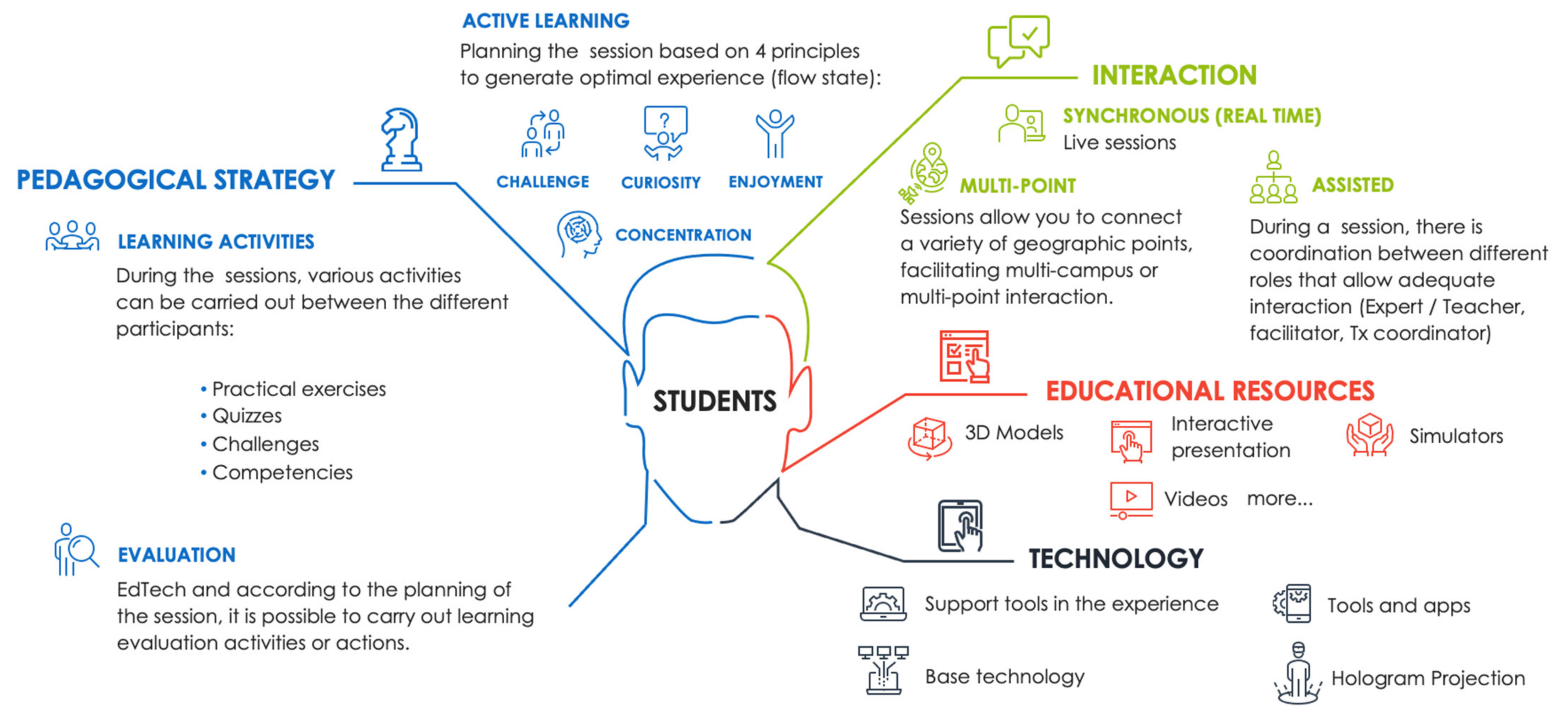
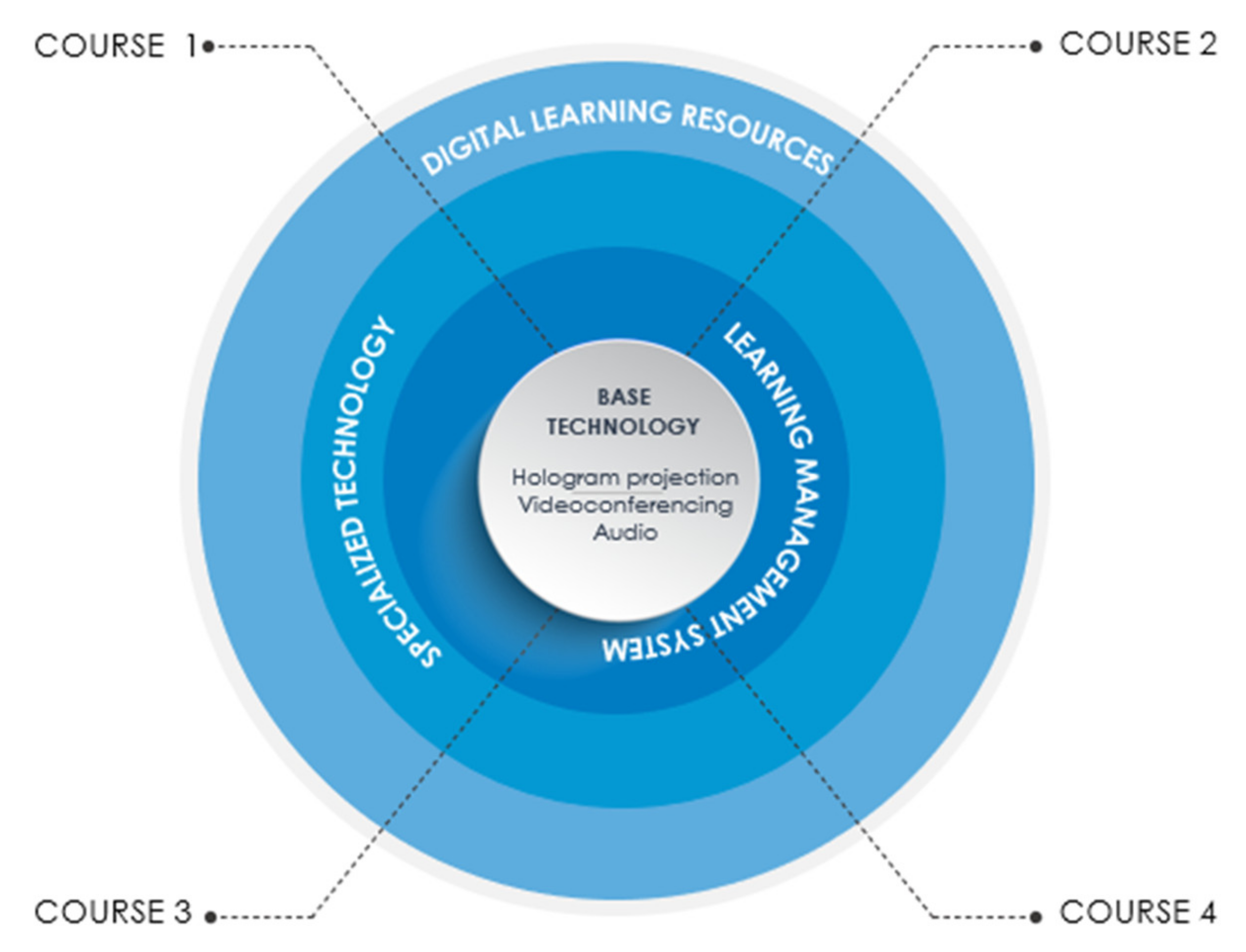
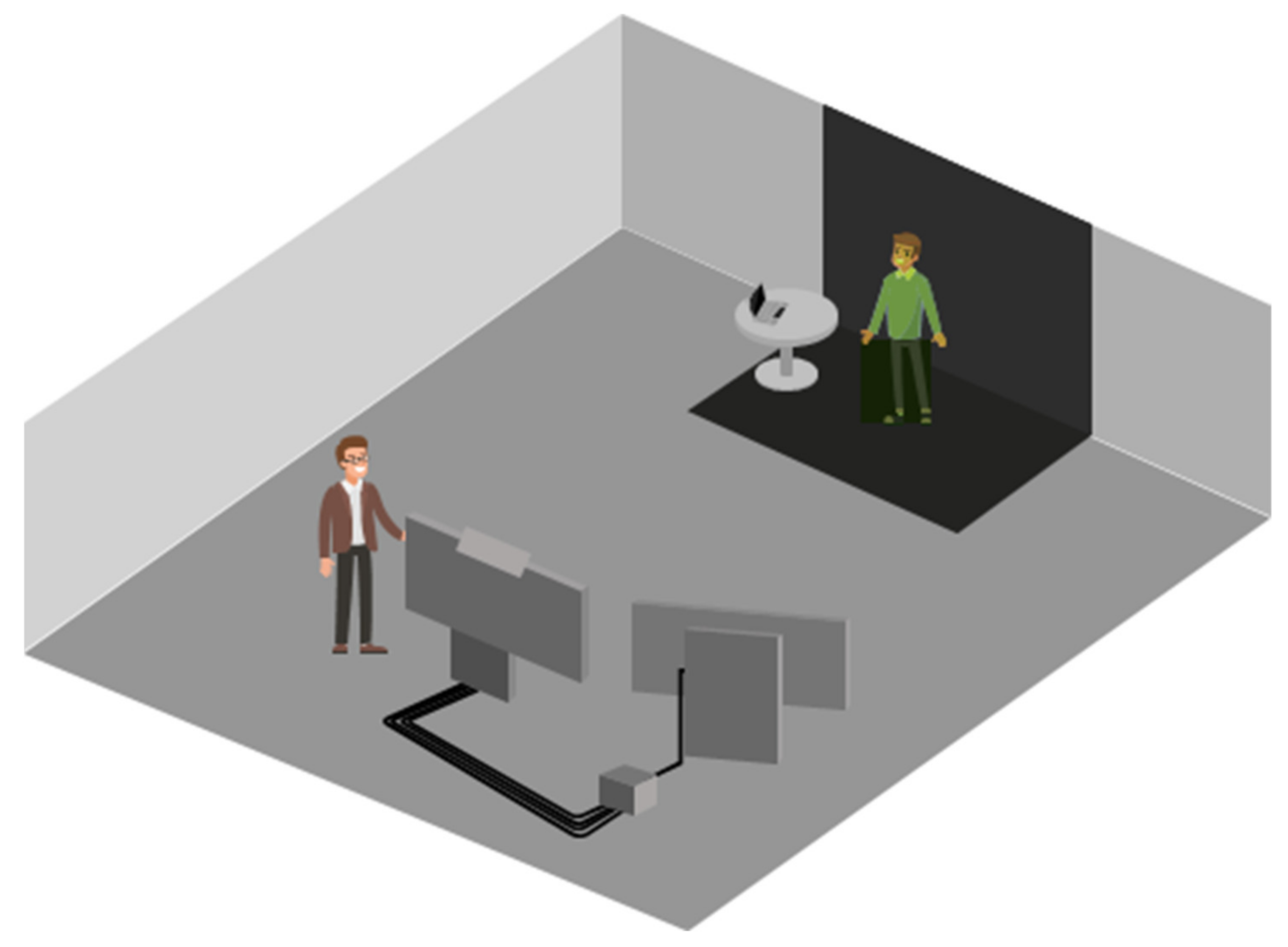
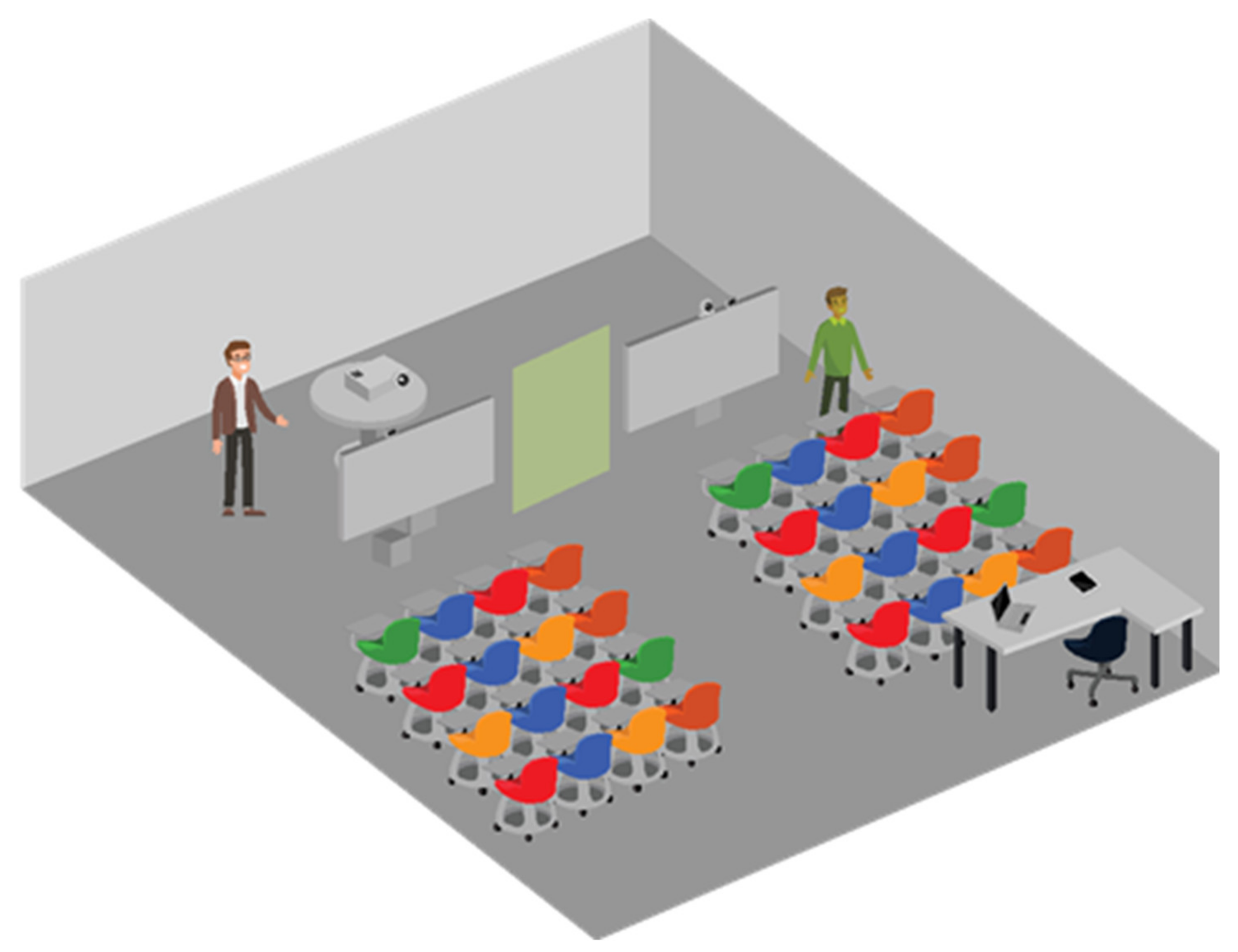

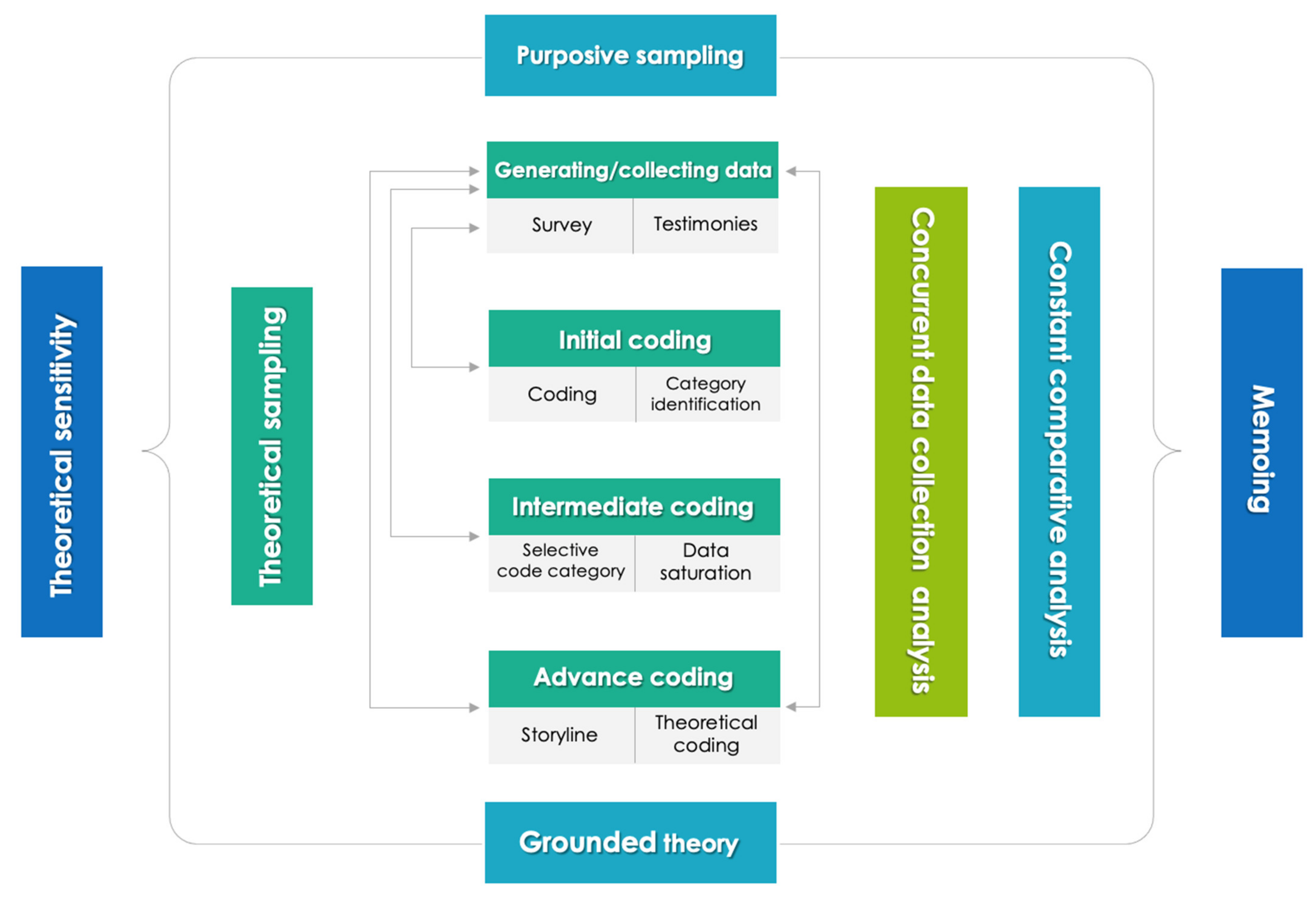
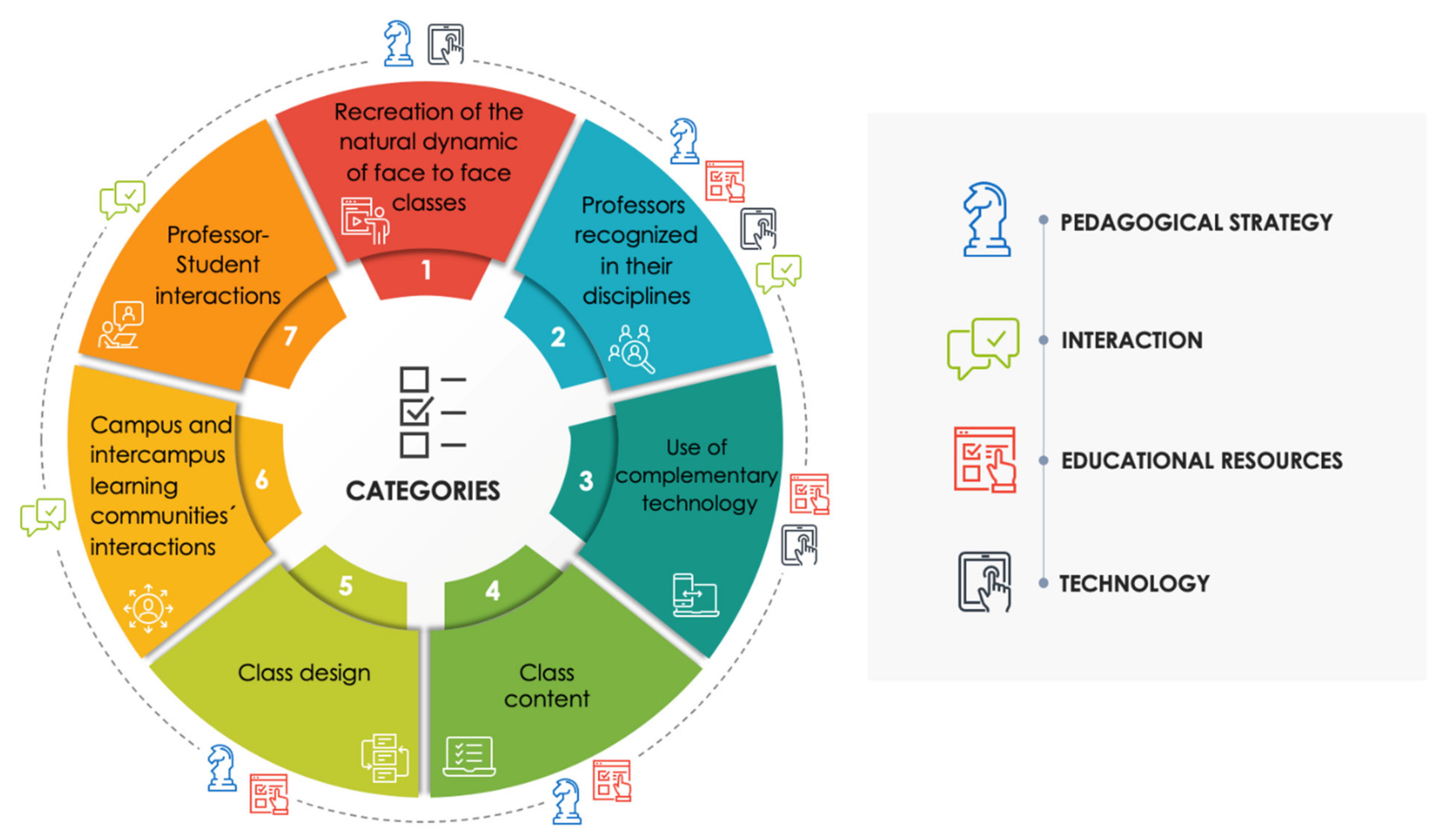
| Phase | Segment | Academic Intervention |
|---|---|---|
| Engagement | Icebreaker | Beginning the topic, the professor captures the students’ attention and presents the learning objectives. |
| Informing | Share knowledge | The professor transmits knowledge to the students through different digital educational resources, such as interactive presentations, videos, and specific tools. |
| Individual practice | Interactive activities | The professor formulates questions through educational tools, leading students through a phase of analysis, reflection, and understanding of previously transmitted knowledge. |
| Collaborative practice | Collaborative activities | The professor develops skills and competencies in the students through practice and teamwork. |
| Summative assessment | Evaluation activities | The professor includes different types of evaluation activities. |
| Engagement and students’ reflections | Closing activities | The professor closes the topic seen in class and connects it to the topic of the next session. |
| Educative Intention | Digital Learning Resources | Learning Output | Type Of Evidence | Interaction |
|---|---|---|---|---|
| Icebreakers | -Kahoot -Menti | Answer | Motivation and engagement | Individual |
| Share knowledge | -Explain Everything -Simulators -Interactive presentations -Chatbot -APP | Contents presented by the professor through technological resources | Questions and knowledge application | Professor-student |
| Interactive | -Kahoot -Menti -Chatbot -Art3D for augmented reality | Analyze, evaluate, and create | Motivation, engagement, and knowledge application | Individual |
| Collaborative | -Google Drive | Analyze and apply | Activities and projects | In teams |
| Closure/ evaluation | -Kahoot -Menti | Evaluate | Quizzes | Individual |
| Students 567/Responses 194 | ||
|---|---|---|
| Course | Number of Students | Responses |
| Star Expert | ||
| Physics 1 | 32 | 32 |
| Mathematics 1 | 58 | 39 |
| Financial Modeling Programming | 55 | 19 |
| Prospective and History of Industrial Design | 123 | 35 |
| Star Guest | ||
| Physics 2 | 86 | 10 |
| Entrepreneurial Leadership | 133 | 45 |
| Marketing and Creativity | 80 | 14 |
| Grand Total | 567 | 194 |
| Question | Type of Question |
|---|---|
| Open |
| Likert scale 1–5 in increasing preference |
| Open |
| Open |
| Open |
| I Liked the Experience | Count of “I Liked the Experience.” |
|---|---|
| 56 |
| 47 |
| 32 |
| 26 |
| No (I did not like the experience.) | 6 |
| No answer | 27 |
| Grand Total | 194 |
Publisher’s Note: MDPI stays neutral with regard to jurisdictional claims in published maps and institutional affiliations. |
© 2021 by the authors. Licensee MDPI, Basel, Switzerland. This article is an open access article distributed under the terms and conditions of the Creative Commons Attribution (CC BY) license (https://creativecommons.org/licenses/by/4.0/).
Share and Cite
Ramirez-Lopez, C.V.; Castano, L.; Aldape, P.; Tejeda, S. Telepresence with Hologram Effect: Technological Ecosystem for Distance Education. Sustainability 2021, 13, 14006. https://doi.org/10.3390/su132414006
Ramirez-Lopez CV, Castano L, Aldape P, Tejeda S. Telepresence with Hologram Effect: Technological Ecosystem for Distance Education. Sustainability. 2021; 13(24):14006. https://doi.org/10.3390/su132414006
Chicago/Turabian StyleRamirez-Lopez, Carla Victoria, Leticia Castano, Patricia Aldape, and Santa Tejeda. 2021. "Telepresence with Hologram Effect: Technological Ecosystem for Distance Education" Sustainability 13, no. 24: 14006. https://doi.org/10.3390/su132414006
APA StyleRamirez-Lopez, C. V., Castano, L., Aldape, P., & Tejeda, S. (2021). Telepresence with Hologram Effect: Technological Ecosystem for Distance Education. Sustainability, 13(24), 14006. https://doi.org/10.3390/su132414006






